Nilambur
| Nilambur | |
|---|---|
| Town | |
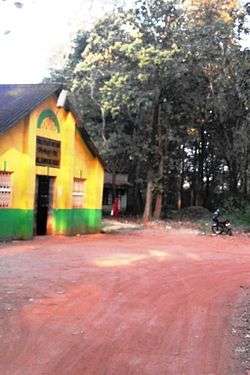 Nilambur Railway Station | |
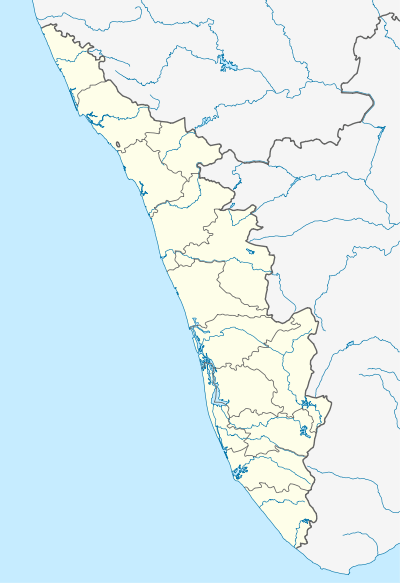 Nilambur  Nilambur | |
| Coordinates: 11°16′37″N 76°13′33″E / 11.27694°N 76.22583°ECoordinates: 11°16′37″N 76°13′33″E / 11.27694°N 76.22583°E | |
| Country |
|
| State | Kerala |
| District | Malappuram |
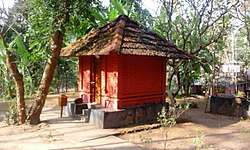
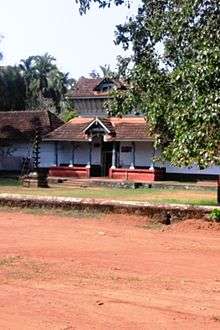
.jpg)
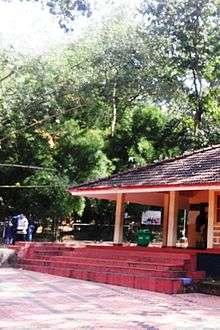
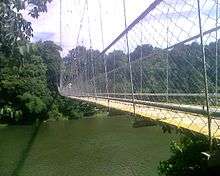
Nilambur is a municipality and a taluk in the Malappuram district of the Indian state of Kerala. It is located close to the Nilgiris range of the Western Ghats on the banks of the Chaliyar River. It is about 40 kilometers from Malappuram city and 24 kilometers from Manjeri on the Kozhikode–Gudalur road called CNG road (Calicut-Nilambur-Gudallur road).
Education
Nilambur is the first municipality in India to achieve primary level education for all its inhabitants. Nilambur is an important tourist attraction in north Kerala because of the variety of its forests that contain bamboo, teak, rosewood, etc.
Attractions
Banglavu Kunnu
Banglavu Kunnu (Bungalow Hill) is a bungalow located in Nilambur. It was built by the Imperial Forest Service in 1929 under British colonial rule. The original purpose of the bungalow was to see the approach of the Tippu Sultan's army via Nadukani Churam. It is situated in Chandakunnu near the Chaliyar River. The bungalow is surrounded by 100-year-old mahogany trees planted during the colonial times for their use as timber which were to be shipped to Portugal by the Portuguese. This practice was threatened by the resistance of the people of the Malabar region against the brutality of the Portuguese, which was stiff and ultimately resulted in victory.
The place is home to many varieties of flora and fauna. The major wild animals include the bonnet macaque, gray langur, wild boar, junglefowl, hare, and porcupine.
Nilambur Kovilakom
Nilambur Kovilakom is a compound of several old palaces and a few new houses occupied by members of the old royal family of Nilambur. Some of the buildings are more than 200 years old.
Gateway of Nilambur
The two kilometre beautiful forest road from Vadapuram bridge to Court road Nilambur is now popularly known as gateway of Nilambur. The road is surrounded by teak plantations on both sides and footpaths are now fully tiled to offer a nice experience to walk through. This place is now emerging as popular destination for a short break on the way to Ooty, Mysore and Bangalore.
Teak forest and plantations
The Nilambur forests are also known for their tribal settlements, vast rain forests, waterfalls and the world's first Teak Museum. Just 2 kilometres (1.2 mi) from Nilambur town, there is the oldest teak plantation in the world, the Conolly's Plot. It is named after H. V. Conolly, the British Malabar district collector, who was instrumental in planting teak there. Chathu Menon, a forest officer, organised the planting of the saplings. Chathu Menon was laid to rest in the teak garden. Kannimari, the plantations' oldest teak tree, is another attraction. The plot extends across 2.31 hectares (5.71 acres) besides the Chaliyar river at the Aruvakode ferry.[1]
Teak Museum
On the Nilambur–Gudallur road, 4 kilometres (2.5 mi) away from the town, there's the Teak Museum, a sub-centre of the Kerala Forest Research Institute. The two storeyed building houses exhibits, articles and details of historic, aesthetic and scientific value, which give information on all aspects of the Teak trees, plantations, and so on.[1]
Conolly's Plot
Conolly's Plot (misspelled as Canoli Plot and Canoly's Plot) named after Henry Valentine Conolly is the world's oldest teak plantations. It is 2 km from the Nilambur town, located in a place called Vadapuram near the government timber depot of Nilambur.
Important landmarks
- Nilambur - Shoranur Railway Line
- [The Nilambur Co-operative College]
- Amal College of Advanced Stud
- Teak Museum, teak forest and Connolly's Plot plantation
- New Amarambalam Reserved Forest
- Nilambur Elephant Reserve
- Manavedhan higher secondary school
- District hospital Nilambur
- Magistrate court Nilambur
- KSRTC sub depot Nilambur
==Naxalite threat==Naxalites, members of the Maoist Communist Party of India. In November 2016, two naxalites were killed near Karulai in an encounter with Kerala police. Naxalite leader Kappu Devaraj of Andhra Pradesh was included in the list of killed in the incident.[2] Villages like Mundakkadavu, Kalkullam and Uchakkulam near Karulai are threatened by Naxalite attacks. Naxalites visit the locality regularly and ask for food and shelter from the tribals. The police are also combing the area regularly but have not arrested any naxalites. On 27 September 2016, there was firing between the Maoists and the Kerala police in this area and no one was injured in this incident.[3][2]
Nearby places
- Adakkakundu
- Akampadam
- Chembrasseri
- Chokkad
- Chungathara
- Edakkara
- Edavanna
- Elambilakode
- Eranhimangad
- Erumamunda
- Karulai
- Kelunairpady
- Kerala-Estate
- Kovilakathumuri
- Mampad
- Manjeri
- Munderi
- Nedumkayam
- Pookkottumpadam
- Pothukal
- Pullipadam
- Thiruvali
- Tiruvali
- Tuvvur
- Vazhikkadavu
- Vellayur
- Vendekumpoil
- West-Chathalloor
Nilambur–Shoranur Railway Line
The railway line from Nilambur to Shornur is part of the main railway line of Kerala. It connects people from the Nilambur area to Shornur, which is an important railway hub of Kerala.
Railway Stations between Nilambur and Shornur:
- Nilambur Road
- Vaniyambalam
- Thodiyappulam
- Tuvvur
- Melattur
- Pattikkad
- Angadippuram
- Cherukara
- Kulukkalloor
- Vallappuzha
- Vadanakkurishi
- Shornur
See also
- Vazhikkadavu border town
- Edakkara town
- Gudalur
- Mango Orange village
- Pandalur town
- Devala, Nilgris
- Nilambur-Shoranur railway line
- Nilambur railway station
- Karulai
- Nedumkayam
References
External links
| Wikimedia Commons has media related to Nilambur. |
| Wikivoyage has a travel guide for Nilambur. |